Methods for treating hibiscus for diseases and pests
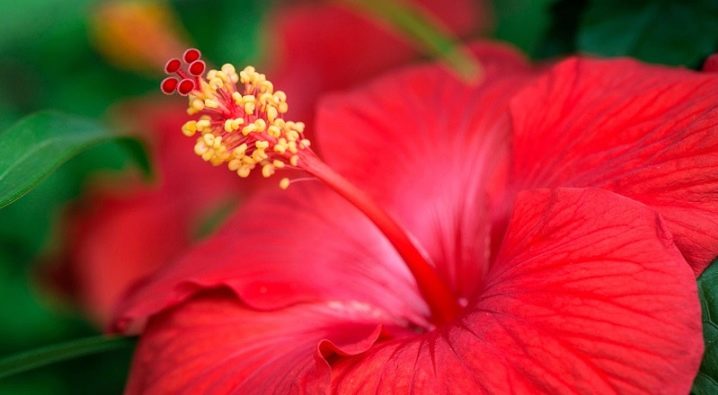
Hibiscus is known to indoor plant lovers as the Chinese rose. This plant of the malvaceous family came to us from Asia. It, as it turned out, perfectly takes root in our latitudes. It is actively grown at home - the flower is loved for its lush flowering, which lasts almost all year round, from early spring to late autumn. Another feature of hibiscus that pleases flower growers so much is longevity, some specimens can live up to 20 years.
Of course, for this, the owner of the flower must comply with a number of conditions: take good care of it, fight pests and other ailments in time that can harm the Chinese rose. We will pay attention to these issues in our article.
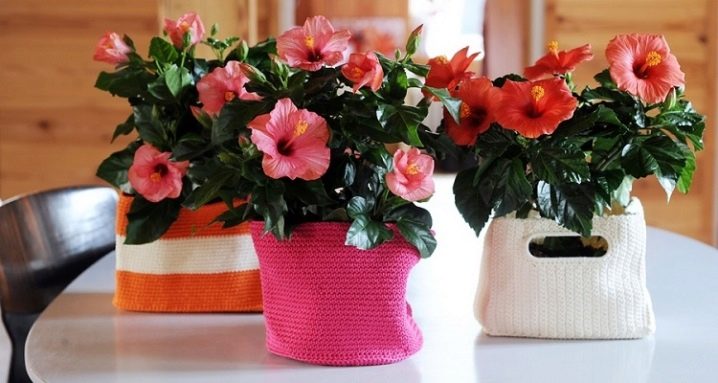
Symptoms and Causes
The most innocuous problems with hibiscus can arise from errors in the conditions of detention. If you see that the appearance of a flower changes - its leaves curl, flowers fall too early, or spots unusual for a plant appear on the leaves - most likely something was done wrong. The following results are obtained:
- stay in a room that is too hot or overheated by the sun;
- lack of moisture in the leaves;
- hit of scorching sunlight;
- drafts;
- leaf contamination;
- excessive watering, due to which the land becomes too wet;
- use of bad water;
- pests;
- insufficient or excessive feeding;
- the need for transplantation.

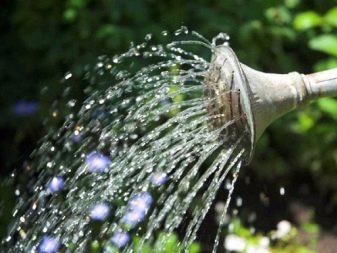
Sometimes the diagnosis can be made by the condition of the leaves and flowers. We are talking about diseases caused by extremely unsuitable conditions of detention.
- The leaves turn yellow and fall off. Most likely, the flower is experiencing discomfort due to the condition of the soil - it is either not watered enough, or, conversely, is too moisturized. Also, temperature jumps can lead to this result.
- Leaves curl inward. This indicates insufficient humidity in the room. You need to spray water from a spray bottle.
- The leaves are down and dry up. In this case, there are several possible reasons: hot and dry air, dry land, lack of light.
- The top turned yellow, but remained firm. This phenomenon often provokes an excess of calcium. It can occur due to too hard water.
- Falling buds. Many growers are frustrated by the too rapid fall of flowers. Unfortunately, it is impossible to answer unequivocally why this is happening. Hibiscus can lose buds due to the lack of nutrients in the soil, due to its excessive dryness, or due to temperature fluctuations in the room (drafts, overheating).
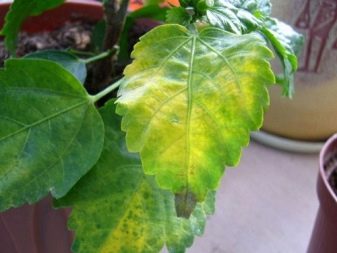
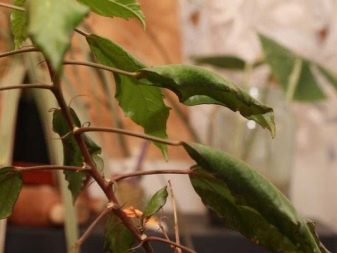
Common diseases
Consider the more serious problems that growers face when growing hibiscus. Here is a description of the most common flower diseases.
Non-infectious chlorosis
This condition leads to the fact that photosynthesis in the plant is hampered, and as a result, the production of chlorophyll. The disease is given by yellowed or faded leaves, growth retardation, the top can be extended, but new flowers and leaves do not appear on the hibiscus. In most cases, this indicates a deficiency of nutrients. More precisely, the cause will be helped to establish the leaves of the flower.
When the veins of young foliage begin to fade first, the plant most likely lacks sulfur. If, on the contrary, young leaves change color, and the veins remain bright green, then the flower lacks iron. The lower old sheets are considered separately: if at first only the veins, and then the whole sheet, changed color on them, then we can talk about nitrogen chlorosis. Due to the lack of magnesium, the tips of old leaves change color, and they can turn yellow, red or turn orange. Dots of the indicated colors indicate a zinc variety of the disease.
Treatment: diagnose the condition of the leaves and select the flower food with the highest concentration of the missing trace element.
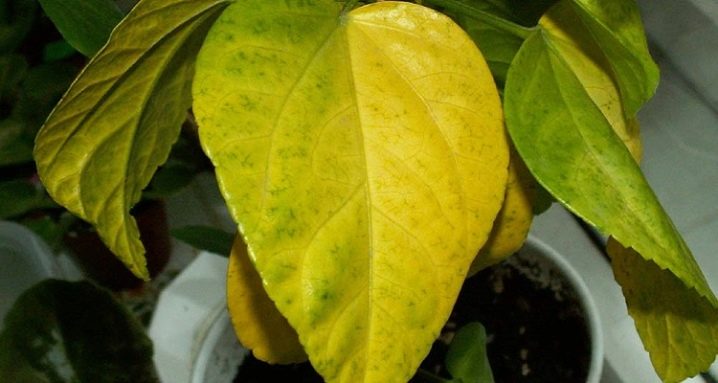
Root rot
Many flower diseases are difficult to diagnose, since they are hidden underground. Sometimes, with excessive watering, fungi are activated in the soil, which actively multiply and begin to adversely affect the root system. As a result, the leaves turn yellow, and sometimes even darken and fall off.
Treatment: Carefully remove the flower from the pot and prune the darkened roots. After a couple of days, plant a Chinese rose in a new land flavored with carbendazim. After transplanting, provide the plant with a comfortable temperature and light conditions. Such measures will help only if the disease has damaged a small part of the roots. In some cases, the roots completely darken and become limp, then the hibiscus dies. In some cases, the roots begin to rot due to mushroom gnats, namely their larvae. Then insecticides are indispensable.
If the source of problems is a nematode, as indicated by swollen roots, then it is better to discard the flower so that it does not infect all other plants.
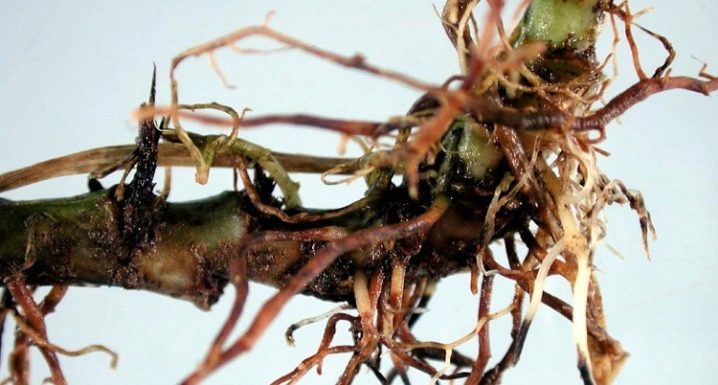
Vascular wilting
In this case, we are talking about the viral nature of the disease. Fusarium and verticillosis lead to this ailment. As a result, the branches dry out first, and then the trunk. If you do not take action in time, then the whole plant withers pretty quickly.
Treatment: the affected areas of the plant are cut off, engaging healthy areas in order to surely get rid of viruses. After that, the flower must be treated with such means as "Thunder-2" or "Trichopol"
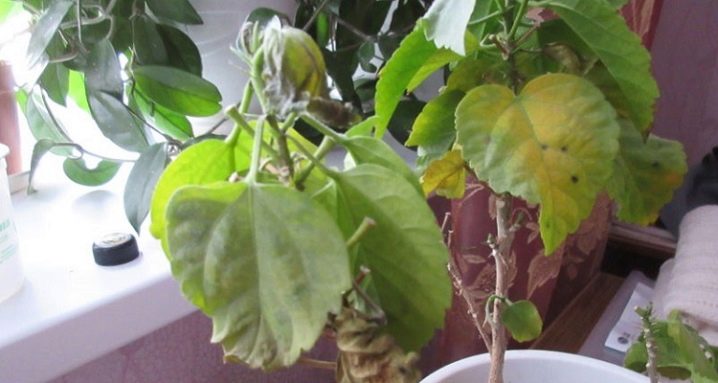
Rust
The affected plant changes its appearance - its shoots look thick and have an irregular shape. The disease clearly manifests itself in the spring, when a rusty bloom is noticeable on the branches at the blossoming buds and at the root. The initial stage of the disease allows you to simply remove the affected areas of the plants. If the disease has affected most of the hibiscus, then fungicides such as Bactofit or 1% Bordeaux liquid should be used at intervals of one or two weeks.

Powdery mildew
The fungus settles not only in the root system, but also on the surface of branches, leaves or buds - the whole plant is sick. This is evidenced by the formation of a white coating. Another concomitant symptom is deformation of flowers. Usually, the symptoms make themselves felt at the end of July: the leaves become covered with brown spots, and then the plant begins to shed the leaves. This disease often affects not only hibiscus, but other roses as well.
Treatment: if the ailment is detected early, then you can try spraying with soapy water - 20 grams of soap and 2 grams of copper sulfate per liter of water. A solution of soda is also used against powdery mildew - it is prepared at the rate of 2 tablespoons per liter of water.
You can also use antibiotics, for example, tetracycline or ampicillin in a ratio of 0.25 grams per 1 liter of water.

Pests
Pests are not always easy to spot black beetles. They can be almost invisible to the eye or even cleverly hidden. However, it will not be difficult for an experienced grower to determine that the problem of a flower is in parasites, and not in negative external factors or any diseases. Usually, these or those traces remain on the plants from them. This can be slippery deposits and other visible changes in the leaves and stem.
- Greenhouse and tobacco whitefly. From them, the leaves of the Chinese rose not only change color to yellow, but also become more sticky.On the reverse side, larvae or adult insects are hiding. To remove them, you need to use the funds "Biotlin", "Fufanon", "Aktara" and the like. You can also use potash soap.
- Spider mite. Dried fragments gradually appear on faded leaves with yellow dots. The tick itself settles in the same way as the whitefly on the back of the leaves, where it weaves its web. In the fight against the pest, soap, mineral oil, or even more powerful means - "Akarin", "Lightning", "Fitoverm" are used.
- Aphid. She settles in the very buds of the Chinese rose or new foliage. Flowers that have changed shape become sticky. To cope with these diseases, tobacco dust is used along with soap. Florists also recommend using such products as Biotlin, Akarin, Decis.
- Scorms. They can most often be detected by light discharge in the area of the petioles. Mineral oil or "Aktofit" is used to remove them.
- Shields and false shields. The pest makes itself felt by the fact that small brown bumps appear on the leaves of the hibiscus. If the affected area is not so large, then they are removed manually, and the traces of stay are smeared with mineral oil. In more difficult cases, an insecticide is used in the fight against the shield.
- Gall midge. Because of her, unopened flowers begin to turn yellow and fall off. This is because they become the place where the midge eggs are laid. Noticing this pest on a hibiscus, the buds are cut off, after which the soil is sprayed with any suitable remedy for earth pests.
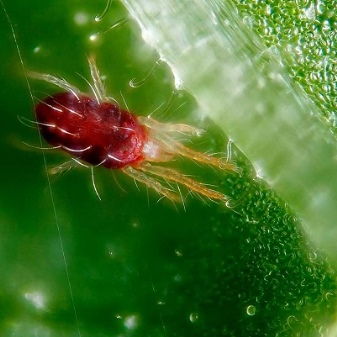
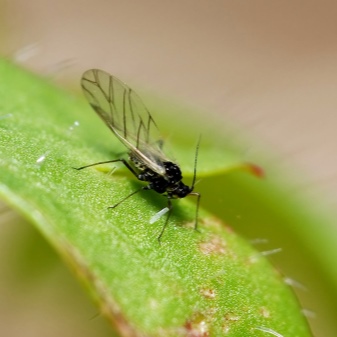
How to save a flower?
As you learned, how to deal with flower diseases depends on the specific case. Diseases can be of a different nature: bacterial and viral diseases, and pest infestations are possible. If folk remedies like soapy water do not work, flower growers turn to specialized stores, where you can buy funds for any occasion. Let's summarize the information about these drugs.
If insects are the problem, an appropriate insecticide is usually used. The most popular are the means "Fitoverm", "Aktara" or "Kleschevit". They do not harm people and at the same time are highly effective. Fungicides are chemicals that kill fungal infections. They are also sometimes used for prophylaxis even at the stage of seed preparation. In this capacity, for the treatment of hibiscus, you can use "Baktofit".
To rid a flower of viral diseases, drugs are also needed that kill harmful bacteria, such as "Thunder-2" or "Trichopol".

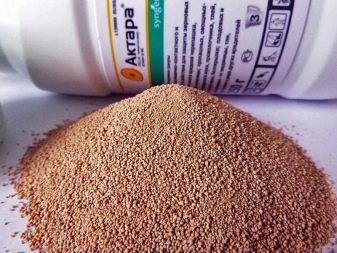
Care rules
In order not to have to treat the plant in the future, you need to create comfortable conditions for it in everyday life. Moreover, sometimes the rules listed below help to cure plants in case of an already onset disease.
- Water the flower according to its needs, that is, you need to do it regularly, but not too intensely. Otherwise, the earth will become damp and become fertile soil for the fungus.
- In summer, hide hibiscus from the scorching sun so that burns do not appear on its leaves.
- Fertilizers should be applied according to the instructions, too much with some substances has a detrimental effect on the condition of the plant.
- In winter and autumn, the Chinese rose no longer needs so much water. Reduce watering during winter.
- And spraying with water should continue all year round, as they are necessary for the normal moisture of the flower itself.
- Do not forget to put a drainage layer in the pot that traps moisture in the right amount.
Hibiscus attracts with its large bright flowers and large size. Thanks to these plants, you can turn your balcony into a blooming garden. For some, one Chinese rose on the windowsill is enough.
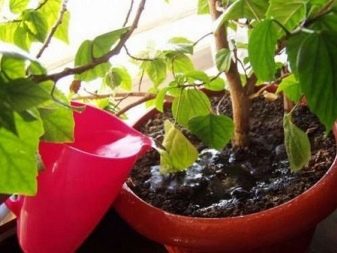
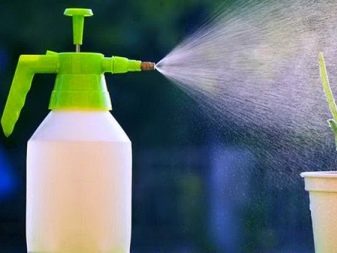
In any case, this is a valuable specimen in a greenhouse, which, with proper care, can delight the owner for many years.
In the next video, various methods of treating hibiscus for diseases and pests are waiting for you.






























Thanks for the helpful article. Tell me, if there is powdery mildew on the leaves, can you sprinkle the leaves with water?
During the fight against powdery mildew, it is necessary to completely abandon spraying and, if possible, take the affected specimen to a brighter, sunny place until the moment the powdery mildew is cured. And you need to water strictly after the topsoil dries out.
The comment was sent successfully.